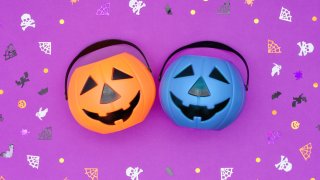
Blue Halloween candy buckets have become a way to signal that a trick-or-treater has autism, inspired by one mom's viral post. But they're also controversial.
"Blue buckets are meant for kids with autism that cannot communicate with others, so if someone knocks and doesn't say 'trick or treat,' don't take it as them being rude or weird," reads one Facebook post that has been shared many times, showing image of text over a big store display of blue jack-o'-lantern buckets. "They deserve to enjoy Halloween like everyone else."
Others say the trend is well-meaning, but harmful.
“Nobody should have to disclose a diagnosis in exchange for kindness," Keri Chavarria, a mother of 7-year-old twins with autism wrote on Facebook.
Get top local stories in DFW delivered to you every morning. Sign up for NBC DFW's News Headlines newsletter.
Why are blue buckets controversial?
“Some parents might see the blue bucket as a way to help our kids,” Chavarria wrote in her post. “I know the many (many) people who alerted me to the idea did so with good intentions. Our society is becoming more aware of autism, more open to inclusion, and my kids will benefit from that. But they also shouldn’t have to tell a stranger they have autism in order to get some chocolate.”
Chavarria says she understands all too well how Halloween can be challenging when you or your child has autism.
Entertainment News
"It’s gotten a little better each year but when the boys were toddlers, I often described Halloween as a 'dumpster fire,'" Chavarria tells TODAY.com. "Halloween is so overstimulating, especially if a child can't verbalize how they feel, has a sensory reaction to their costume or isn't used to being out at night with lots of people."
"Some people stared at my kids if they didn't say 'trick or treat,'" she recalls.
Although Chavarria prepared her sons for what to expect on Halloween (ie: Don't walk into the homes of people handing out candy), the night didn't always go smoothly.
"During the early years, there was a lot of crying, screaming, laying on the street and not collecting much candy," she says.
Chavarria is happy to educate those curious about her children's behavior, but they won't be carrying blue buckets on Halloween.
"Kids deserve to go trick-or-treating like everyone else without a symbol that says "I'm different" because we already live that every day," she says.
It's all about individual choice
According to Kerry Magro, a public speaker and activist who was diagnosed with autism at age 2, using a blue Halloween bucket should be a family's individual choice based on the child's needs and desires.
"It's ideal to give the individual an opportunity to choose whether or not they want to use a blue bucket and parents should validate that decision," Magro tells TODAY.com.
Magro flags possible downsides to carrying a blue bucket.
“There is a concern with unintentionally stigmatizing children with autism, or confusing the color blue with teal,” he says. Teal symbolizes food allergy awareness.
Lindsey Walker, whose 18-year-old daughter has autism, does not use blue buckets on Halloween.
"I think the idea behind it was well-meant, but not well-received by some of the autism community, myself included," Walker wrote in a Facebook post. "It can label kids on what is meant to be a judgement-free and happy time ... I understand the idea behind it, but my child’s safety and privacy are more important to me."
Walker tells TODAY.com that blue buckets can overcomplicate an already-chaotic evening.
"Halloween is dark and hectic," she notes. "A lot of people probably aren’t looking at buckets when handing out candy."
Magro notes there's an alternative for families who want to communicate their child’s needs or challenges more directly.
"I've seen trick-or-treat bags with messages that read, 'I have autism and don't speak but I'd still like candy,'" he says.
This story first appeared on TODAY.com. More from TODAY:



